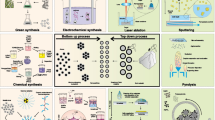Summary
Silver accumulation and processing in mouse peritoneal macrophages was studied in vitro by autometallographic visualization of intracellular silver. During the first 24 h of incubation in a medium containing from 5 μM to 20 μM of silver lactate, an inverse relationship between silver concentration in the former and visualizable silver in macrophages was recorded. Later, however, the cells treated with higher silver concentrations accumulated most silver. Cells exposed to silver concentrations above these levels exhibited acute coagulation necrosis and disintegrated within the first 15 min of silver treatment. Macrophages treated with silver lactate concentrations not causing acute cytotoxicity showed no impairment of their phagocytic, migratory or interferon-producing capacities. The significance of autointerference in silver accumulation and processing in macrophages is discussed, and a functional defect in the lysosome/ phagosome system is suggested as a basis for the phenomenon.
Similar content being viewed by others
References
Castranova V, Bowman L, Miles PR, Reasor MJ (1980) Toxicity of metal ions to alveolar macrophages. Am J Industr Med 1:349–357
Cherian MG, Nordberg M (1983) Cellular adaptation in metal toxicology and metallothionein. Toxicology 28:1–15
Cook JA, Hoffmann EO, DiLuzio NR (1975) Influence of lead and cadmium on the susceptibility of rats to bacterial challenge. Proc Soc Exp Biol Med 150:741–747
Danscher G (1981) Light and electron microscopic localization of silver in biological tissue. Histochemistry 71:177–186
Danscher G (1984) Autometallography. Histochemistry 81:331–335
Danscher G, Rungby J (1986) Differentiation of histochemically visualized mercury and silver. Histochem J 18:109–114
De Maeyer E, De Maeyer-Guignard J (1983) Delayed hypersensivitiy to Newcastle disease virus in high and low interferonproducing mice. J Immunol 130:2392–2396
Diplock AT, Green J, Bungan J, McHale D, Muthy IR (1967) Vitamine E and stress. 3. The metabolism of D-α-tocopherol in the rat under dietary stress with silver. Br J Nutr 21:115–125
Ellermann-Eriksen S, Justesen J, Mogensen SC (1986) Genetically determined difference in the antiviral action of α/β interferon in cells from mice resistant or susceptible to herpes simplex virus type 2. J Gen Virol 67:1859–1866
Faith RE, Luster MI, Kimmel CA (1979) Effect of chronic developmental lead exposure on cell-mediated immune functions. Clin Exp Immunol 35:413–420
Fowler BA, Nordberg GF (1986) Silver. In: Friberg L, Nordberg GF, Veuk UB (eds) Handbook on the toxicology of metals. 2’nd edition. Elsevier, Amsterdam
Fuchs U, Franz H (1971) Präparativ erzielte Silberanreicherung bei experimenteller Argyrose. Elektronmikroskopische Befunde. Exp Pathol 5:163–174
Hemphill FE, Kaeberle ML, Buck WB (1971) Lead suppression of mouse resistance to salmonella typhimurium. Science 172:1031–1032
James TH (1977) The theory of the photographic process. Macmillan, New York
Kiremidjian-Schumacher L, Stotzky G, Likhite V, Schwartz J, Dickstein RA (1981) Influence of cadmium, lead and zinc on the ability of sensitized guinea pig lymphocytes to interact with specific antigen and to produce lymphokine. Environ Res 24:96–105
Koller LD, Kovacic S (1974) Decreased antibody formation in mice exposed to lead. Nature 250:148–149
Koller LD, Roan JG (1977) Effects of lead and cadmium on mouse peritoneal macrophages. J Reticuloendothel Soc 21:7–12
Leirskar J (1974) On the mechanism of cytotoxicity of silver and copper amalgams in a cell culture system. Scand J Dent Res 82:74–81
Loose LD, Silkworth JB, Simpson DW (1978) Influence of cadmium on the phagocytic and microbicidal activity of murine peritoneal macrophages, pulmonary alveolar macrophages and polymorphonuclear neutrophils. Infect Immun 22:378–381
Matuk Y (1983) Distribution of radioactive silver in the subcellular fraction of various tissues of the rat and its binding to low molecular weight proteins. Can J Physiol Pharmacol 61:1391–1395
Mogensen SC (1982) Macrophage migration inhibition as a correlate of cell-mediated immunity to herpes simplex virus type 2 in mice. Immunobiology 162:28–38
Pedersen EB, Haahr S, Mogensen SC (1983) X-linked resistance of mice to high doses of herpes simplex virus type 2 correlates with early interferon production. Infect Immun 42:740–746
Petering HG (1976) Pharmacology and toxicology of heavy metals: Silver. Pharmacol Ther A 1:127–130
Rungby J (1986) Exogenous silver in dorsal root ganglia, peripheral nerve, enteric ganglia, and adrenal medulla. Acta Neuropathol 69:45–53
Rungby J, Danscher G (1983) Neuronal accumulation of silver in brains of progeny from argyric rats. Acta Neuropathol 61:258–262
Rungby J, Hultman P, Ellermann-Eriksen S (1987) Silver affects viability and structure of cultured mouse peritoneal macrophages and perixodative capacity of whole mouse liver. Arch Toxicol (in press)
Selye H, Tuchweber B, Bertok L (1966) Effect of lead acetate on the susceptibility of rats to bacterial endotoxins. J Bacteriol 91:884–890
Tanaka T, Hagashi Y, Ishizawa M (1983) Subcellular distribution and binding of heavy metals in the untreated liver of the squid, comparison with data from the livers of cadmium and silver exposed rats. Experientia 39:746–748
Truscott RB (1970) Endotoxin studies in chicks: Effect of lead acetate. Can J Comp Med 34:134–137
van Furth R, Cohn ZA, Hirsch JG, Humphrey JH, Spector WG, Langevoort HL (1972) The mononuclear phagocyte system: a new classification of macrophages, monocytes, and their precursor cells. Bull WHO 46:845–852
Winge DR, Premakumar R, Rajagopalan KV (1975) Metalinduced formation of metallothionein in rat liver. Arch Biochem Biophys 170:242–252
Zukoski CF, Chvapil M, Carlson E, Hauler B, Ludwig J (1974) Functional immobilization of peritoneal macrophages by zinc. J Reticuloendothel Soc 16:6a
Author information
Authors and Affiliations
Rights and permissions
About this article
Cite this article
Ellermann-Eriksen, S., Rungby, J. & Mogensen, S.C. Autointerference in silver accumulation in macrophages without affecting phagocytic, migratory or interferon-producing capacity. Virchows Archiv B Cell Pathol 53, 243–250 (1987). https://doi.org/10.1007/BF02890249
Received:
Accepted:
Issue Date:
DOI: https://doi.org/10.1007/BF02890249




